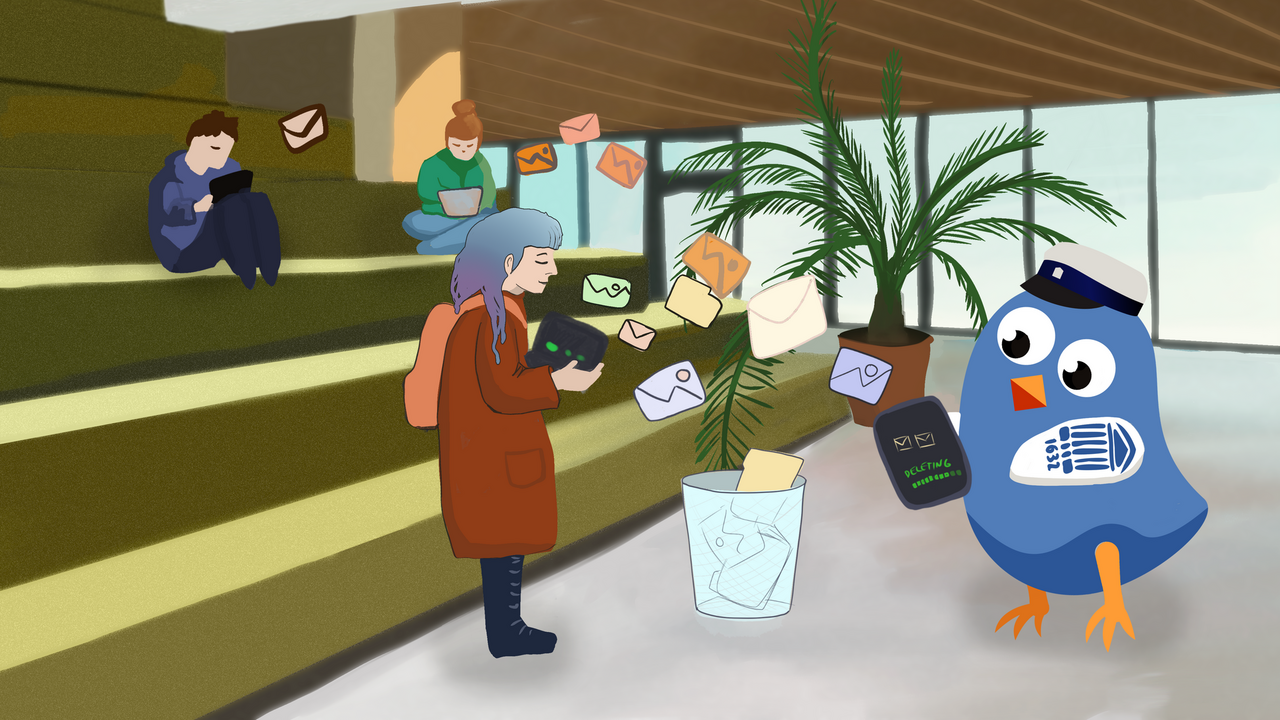Record amount of digital waste was deleted during the university’s Digital Cleanup Month

- 3533.22 GB of data from their computers (about 3,600,000 documents),
- 397.79 GB of data from their smart devices (about 400,000 photos),
- 382.38 GB of data from their email inbox and cloud platforms (about 5,300,000 emails).
- Article “Maailma viiest miljardist internetikasutajast igaüks istub otsekui prügimäel” by Head of IT Support Service Meelis Kogermann, project manager of the Digital Cleanup Month Joonas Masing and Professor of Artificial Intelligence Meelis Kull in Tartu Postimees
- Meelis Kogermann’s and Joonas Masing’s recommendations for digital decluttering on Geeniuse digisaade
General principles for reducing digital waste
- Before buying a new device, consider whether you really need it.
- If a device does not work properly or is out of date, don’t buy a new one immediately but have it repaired.
- If you no longer need your old device, don’t leave it in a drawer, but consider donating, selling or recycling it.
- Choose an energy-efficient product that has a long lifespan and is made from sustainable materials.
- Use cloud services, as storing data in the cloud reduces the need for physical storage space.
- Reduce unnecessary data storage.
Here are some principles to help you organise your computer folders and documents.
- Keep your desktop clean and organised.
- Create a clear and logical structure for document folders.
- Sort documents and files by size, and delete unnecessary large files to free up space on your computer.
- Allow your computer to automatically start only the applications you really need.
- Keep your downloads folder tidy and organised.
- Empty the recycle bin regularly.
- Consider using a password management application for security and convenience.
- Clean up your browser – clear your cache and page history and remove unnecessary plugins.
Read digital cleaning guides on how to free up space on your computer.
When cleaning your smart device, the following principles may be helpful.
- Uninstall the apps you no longer use. Also, check your app cache and delete unnecessary data.
- Make sure your device software and apps are up to date. This will ensure optimal performance and security.
- When you switch phones, choose carefully what you transfer to your new device. Keep only the files and apps you really need.
- Delete unnecessary photos, videos and documents, and get rid of duplicate files. If there are similar photos, keep only the best and delete blurry ones.
- Sort files by size. Delete large, unnecessary files and apps to free up space on your device.
- Find a cloud service of your choice to back up important photos and data. This way, you will not lose important items when your device crashes or gets lost. When choosing a cloud service, remember that your personal items should not be stored in the university’s cloud.
- Don’t forget to clean the screen and body of your device to keep it clean and in good condition.
The following principles may be helpful when cleaning and organising your mailbox.
When you filter and click the Sort by button, it is possible to arrange all emails by size and delete useless, large-size emails. This will help you reduce your mailbox size and make it easier to find important items in the future.
Use the search function to find and delete unnecessary emails, such as old invoices or notifications.
Sort emails by subjects or projects into folders.
Check and empty the Junk email and Promotions folder regularly to avoid accumulating unnecessary emails there. If you receive many newsletters that you do not read, consider unsubscribing.
If there are emails that you do not need every day but want to preserve, you may archive them. In the future, you can access them in the Archive folder.
It is important to remember that the purpose of organising your mailbox is not to delete the emails and files that you need but to review the accumulated emails critically and delete anything unnecessary.
See also IT helpdesk guides on How to free up space in Microsoft 365 and How to get more space in Google services.
When cleaning digital environments, the following may be helpful.
Take a look at all the files accumulated in OneDrive, Moodle, BigBlueButton, Mahara and LimeSurvey. Make backup copies of important files. You can store them on external hard drives, cloud platforms or other backup solutions to avoid losing valuable information. Delete any old, outdated or useless files.
Check that all systems and applications are up to date to ensure the security and stability of your environment. Remove unnecessary plugins.
Delete the accounts you no longer use and update the data of necessary accounts.
Review your privacy and security settings for each environment. Make sure that you use strong passwords and two-factor authentication, where possible.
Check access rights to shared files and sites. Remove access rights from people who do not need them.
Please remember that the university’s cloud platform is not intended for storing personal files.





